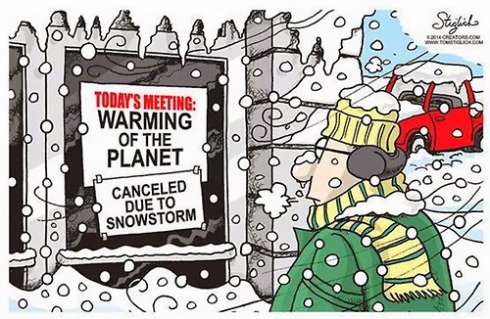Call it the polar vortex or the arctic invasion. By whatever name, we are still seeing negative temperatures in March and random downfalls of snow.
Your logic may fall upon the following lines: Global warming means that temperatures should be rising, not sinking. It’s March…and there’s still snow out. So…global warming is a sham!
Well no, not at all. An extended winter (or a cold spring.. whatever you want to call it) does not disprove global warming any more than the record heat waves hitting Australia right now. But since critics- like Donald Trump – seem confused on this point, it’s worth recapping a few basic points:
- Local isn’t global. This year’s severe cold isn’t affecting the whole planet. The term “global warming” typically refers to the rise in the average temperature of Earth’s climate system since the late 19th century, as well as predictions for future warming. A key bit there is “Earth’s average temperature.” It can be very cold in one part of the world and very hot in another at the exact same time. Yes, December might have been unbearably cold but when you add up all the data, December 2013 was tied for the 2nd-hottest December on record since 1979.
- Weather isn’t climate. Weather is what happens moment to moment in the atmosphere; climate is the long-term average of weather over time in particular places. Climate is what you expect, and weather is what you get. Global warming doesn’t prevent cold snaps or snow storms.
- Heavy snowstorms are still possible as the planet warms. This may sound odd, but it makes some intuitive sense. Global warming isn’t going to eradicate winter temperatures (as we have seen over the past several months). But a warmer planet will allow the air to hold more moisture on average. So, in theory, you could have the ingredients for more intense winter storms.
So yes, global warming does exist. It’s worth noting that global warming will have different affects on temperatures in different parts of the world, hence the shift from ‘global warming’ to the more appropriate ‘climate change.’ While the first term is still correct, since the planet is on average seeing warmer and warmer temperatures, some regions may see wetter and colder weather. The basic explanation for this is that as heat increases, more water evaporates around the world, putting more vapour into the atmosphere- which can cause heavier rainfalls and worse storms, and create cooler weather patterns. The warming of the planet is already raising sea levels, acidifying oceans, melting glaciers and intensifying heat waves, downpours, droughts and wildfires.
So there you go. It’s cold outside. The planet’s still warming. Strange but true.

